Frankenstein, The Puppet October 13, 2008
Posted by leskanturek in 3-D work, Class Topics, Frankenstein, Frankenstein Illustrated, Visually Cool & Relevant.Tags: Frankenstein, Puppets, Theatre
add a comment
The following are some info and images from various puppet productions of Frankenstein. Having not attended these productions I’ve cited the original URL at the end of the entry. As always, all the work shown below belongs to their respective creators/owners.
Interestingly enough, I haven’t come across a puppet production of Frankenstein on the web that wasn’t aimed at an adult audience. That might just be circumstance of course this post is hardly a complete bibliography. I would imagine that there are and have been hundreds of productions.
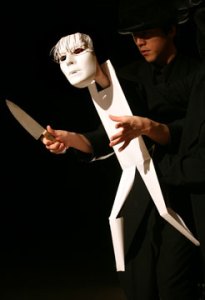 The University in Maryland Department of Theatre presented an adaptation of Frankenstein. Conceived and directed by Colette Searls, with new music by Anna Rubin. The production features set design by Peter Wood, costume design by Celestine Ranney-Howes, light design by Terry Cobb, sound design by Erica Yeager and dramaturgy by Susan McCully. A young scholar makes an astonishing discovery: how to create a new human being out of other people’s dead bodies. Paper sculpture, floating masks, and eerie medical tools bring life to the inanimate in this ghastly tale of human transgression.
The University in Maryland Department of Theatre presented an adaptation of Frankenstein. Conceived and directed by Colette Searls, with new music by Anna Rubin. The production features set design by Peter Wood, costume design by Celestine Ranney-Howes, light design by Terry Cobb, sound design by Erica Yeager and dramaturgy by Susan McCully. A young scholar makes an astonishing discovery: how to create a new human being out of other people’s dead bodies. Paper sculpture, floating masks, and eerie medical tools bring life to the inanimate in this ghastly tale of human transgression.
This production is not recommended for young children.(the above taken from http://www.umbc.edu/blogs/umbcnews/archives/art/index.html)
Open Hand Theatre’s (Syracuse, New York) production of Frankenstein, November 1, 2002. The following is an excerpt from a review by Reviewed by Neil Novelli in the Post Standard.
“…adaptation written by Geoffrey Navias takes the imagination on a wild ride that links Shelley’s story to modern technology and to the mysteries of ordinary life, like childbirth. And along the way, it tells a sort of ghost story that may or may not be true.”
http://www.openhandtheater.org/Reviews.html
Terrapin Puppet Theatre’s production of Frankenstein, director Jessica Wilson, dramaturg/concept development Anne Thompson, puppet design Graeme Davis, puppeteers Kirsty Grierson, Melissa King, Colin Sneesby; Peacock Theatre, Hobart, May 18-29 2004.
Frankenstein photo Glenn Dickson-
http://www.realtimearts.net/article/62/7540
Frankenstein by Neville Tranter
concept, puppets and play NevilleTranter, text & direction Luk Van Meerbeke
http://www.stuffedpuppet.nl/re-frankenstein.html
The Columbia Marionette Theatre’s production: Frankenstein, A Puppet Show
I believe the puppet was created by Lyon Hill the theatre’s artistic Director . flickr.com/photos/puppetman/460661/
Frankenstein/Cultural Icon September 3, 2008
Posted by leskanturek in Class Topics, Frankenstein, Frankenstein Illustrated, Summer Reading Project, Visually Cool & Relevant.Tags: 8th Floor Showcase, Frankenstein illustrators
1 comment so far
A huge looming figure with a flattened head, bolts coming out of either side of his neck, and a halting stride with out stretched arms. The image of Frankenstein is universally recognized by young and old around the globe .Mary Shelley’s haunting novel, first published in 1818, and its themes of the consequences of man wielding the divine spark of human life, instantly captured the imagination of the public. Stage adaptations of the story began five years after the novel appeared. Parodies of the play were performed soon after that. Even those early plays only remotely resembled Mary Shelley’s original novel, they instead paid homage too the novels main themes and catered (much as todays audience) to the public’s love of being frightened.
Part of the power of the myth is that Frankenstein exists as both victim and villain, clown and monster. The creature can be a lovable, bumbling cartoon character pushing kids cereal or an angry, tattooed, anti-establishment punk rocker. The creature has been the subject of plays, movies, and television, action figures, graphic novels, comic books, music and is even an adjective in our language (think Franken-food).
Mary Shelley’s creature is alive and has a life of it’s own.
The monster’s story has been reinterpreted and retold in a wide range of media, and across generations. Each re-imagining of the story adds something to the myth as well as reflecting the time period it’s produced in. In fact, it’s Boris Karloff’s interpretation of the creature (from James Whale’s 1931 movie) that has replaced Mary Shelley’s original description of the monster in the mind of the public.
Frankenstein/Summer Reading Project 2008
Frankenstein, by Mary Shelley was the 2008 selection for the Illustration Department’s Summer Reading Project. All illustration students had the common cultural experience of reading Frankenstein.
The story of Victor Frankenstein, and his scientific offspring present unique challenges to illustrate. There are a number of themes to explore in the original book and how to convey them visually; parental responsibility, and rejection, the moral scope of new technology, point of view, and notions of good and evil, to name a few.
There is the problem of avoiding cliches, images we have all seen before vs. finding a new look to the story.
Frankenstein/Cultural Icon Display, 8th floor showcase
Below is the showcase on the 8th floor with a fraction of the things spawned by the myth of Frankenstein’s Monster. Thank you to Bob Sikoryak, Roger and Mary Bow , and Steven Guarnaccia for their contributions.

 Key to display in 8th floor showcase
Key to display in 8th floor showcase
- Poster for I Was a Teenage Frankenstein, 1957 Released by American International Pictures.
- Playbill for the Broadway musical and VHS box for the original movie (1974) of Young Frankenstein, by Mel Brooks.
- Famous Monsters of Filmland 1965 yearbook, Published by James Warren, edited by Forest J. Ackerman.
- DVD box of The Golem, a silent movie directed by and staring Paul Wegener (as the golem) 1920. (left), small clay golem from Prague. reportedly, Frankenstein Director James Whale screened The Golem and Fritz Lang’s Metropolis (1927) in preparation for Frankenstein. The Golem is a man made creature with no soul, formed out of clay.
- Spread from the third edition (1831) of Frankenstein with engraved vignette titles and frontispieces by Theodor Von Holst.
- Poster for Metropolis (1927) by Fritz Lang. A silent movie taking place in the future (2027) in which among other things a human like female robot is created.
- Still and poster from the 1990 movie, Edward Scissorhands, directed by Tim Burton. Edward is the artificial creation of a scientist (Vincent Price) who died before completing the attachment of his more human like hands.
- Penguin Classics Deluxe Edition of Frankenstein with cover art by Daniel Clowes.
- Frankenstein latex Halloween mask.
- Trading card depicting the cover of Frankenstein comics #2 drawn by Dick Briefer, Published by Prize Publications, 1945 (?).
- View master reels of Frankenstein (1976). Click here to see the images on the reels.
- Frankenstein, Illustrated By Robert Andrew Parker Publisher: Clarkson N. Potter (1976)
- The Diary of Victor Frankenstein, by Timothy Basil Ering (Illustrator), published by DK INK 1997
- Stamps, two British 1997 (drawn portrait by Ian Pollock) stamps , one U.S. , Boris Karloff /Frankenstein portrait by illustrated by Thomas Blackshear II)
- Frankenberry cereal, made by General Mills appeared in 1971. Strawberry flavored with marshmallow pieces. Other monsters were Count Chocula and Boo Berry. Yummy Mummy was a character from 1988 -1993. Frankenberry is still being made just in lower numbers. It’s easiest to find around Halloween.
- Poster for The Curse of Frankenstein ,1957 by Hammer Film Productions a British horror film company. Peter Cushing plays Baron Victor Frankenstein and Christopher Lee plays the creature.
- Bernie Wrightson’s Frankenstein: Or the Modern Prometheus, text by Mary Shelly, illustrated by Bernie Wrightson. Published by Mavel (1980) Youtube documentary on the book and Site devoted to the illustrations.
- Electric Frankenstein! by Sal Canzonieri. Published by Dark Horse (2004)Poster art of the punk rock band Electric frankenstein featuring artwork by Coop, Kozik, Johnny Ace, The Pizz, Lisa Petrucci, Derek Hess, Alan Forbes, among others. Sal Canzonieri is a founder of the band. Misc. art from the book is on display too.
- Happy Birthday Frankie, by Sarah Weeks (Author), Warren Linn (Illustrator), Published by Laura Geringer (1999).
- Cover from the Classics illustrated version of Frankenstein by Mary Shelly. Acclaim Comics, Inc. © Twin Circle Publishing Co., (1958) Painting by Norman Saunders.
- Universal Monsters: Son of Frankenstein 12-Inch figure. The figure comes with an arm, a comic and a display base.
- Paperback book editions of Frankenstein: Signet Classics (1965) Illustrator unknown, Dell Publishing edition (1972), Illustrator unknown, Scholastic (1974) Illustrator Margret Howlett.
- The Cobbler’s Monster, by by Jeff Amano (Author), Craig Rousseau (Author/Artist), Wayne Faucher (Author/Artist), Giulia Brusco (Author), Image Comics (2006). The Frankenstein mythos mingled with Pinnochio among others.
- Frankenstein, illustrated by Lynd Ward, reprint edition. first edition 1934, Published by Harrison Smith and Robert Haas. These have to be seen to be believed . Ward is a master story teller as well as wood engraver. He is probably best know for his novels without words, forerunners to what we call graphic novels. There are a number of places on line to view illustrations from the book. http://www.nijomu.com/blog/?p=200 or http://paganpressbooks.com/jpl/LYNDWARD.HTM I urge you to check out his work, there is a wonderful sense of pathos in the creature that I have not seen anywhere else.
- Bride of Frankenstein poster Directed by James Whale. With Boris Karloff, and Elsa Lanchester as both Mary Shelley and the Bride.
- Frankenstein…the nut cracker.
- Marvel Classics Comics Vol 1 #20 (1977) by Marvel. Cover Artists Gene Colan, Ernie Chan
- Frankenstein comics drawn by Dick Briefer, Published by Prize Publications.
- The 1934 Heritage press version of Frankenstein, illustrated by Everett Henry. This is the only illustration where the “monster appears”. Throughout the book the creature is depicted only as a shadow.
- Advertisement for a 7 foot tall Frankenstein monster for only $1.00 (plus 35¢ for postage and handling of course.) seen in a comic book.
- Halloween Monster bolts
- Video display- now playing…episodes of The Munsters 1964-66
You can also find out more about the Summer Reading Project at : http://www2.parsons.edu/illustration/frankenstein/
Frankenstein Illustrated/ Harry Brockway August 28, 2008
Posted by leskanturek in Art History, Frankenstein, Frankenstein Illustrated, Summer Reading Project.Tags: book illustration, Harry Brockway, wood engraving
add a comment
I do not have much info on this illustrator . The wood engravings that I’ve seen online from the Folio Society’s (UK) 2004 edition of Frankenstein are wonderful interpretations of the characters. A number of Wood engravers have tackled Frankenstein such as Lynd Ward and Barry Moser. Here is what I can dig up (no Frankenstein pun intended) on Mr. Brockway.
(Above) The cover and an interior illustration for the Folio Society’s 2004 edition of Frankenstein.
(Above) Title page
(Above) Frankenstein in the arctic (Right) an early sculpture by Harry (photo from Old Stile Press blog .
British illustrator Harry Brockway was born in 1958, and received a BA from Kingston upon Thames, in sculpture, and a Post-graduate Diploma sculpture from Royal Academy Schools. He taught art and is also trained as stone mason.
He has worked for the the Old Stile Press, where some of his stone carving can be seen. the Greynog Press, The Readers Digest Association and the Folio Society.
I find it perfectly understandable that Mr. Brockway is trained as both a sculptor and a wood engraver. Anyone can tell you that has created wood blocks, or engravings, there is a sculptural aspect to carving wood for printmaking. You usually fall in love with the material that you are carving and the finished block.
Frankenstein Illustrated/Theodor Von Holst August 28, 2008
Posted by leskanturek in Art History, Artists, Frankenstein, Frankenstein Illustrated, Summer Reading Project.Tags: 1831 edition of Frankenstein, Hanry Fuseli, Theodor Von Holst
add a comment
The first edition of Frankenstein was published in 1818. The first instance of it being illustrated is the third edition of 1831 with engraved vignette titles and frontispieces by Theodor Von Holst.
(Above) Pages from the the 1831, 3rd edition, London: Henry Colburn and Richard Bentley. These pages do appear as a spread in the book. (Left) The text on the frontispiece reads: ‘By the glimmer of the half-extinguished light, I saw the dull yellow eye of the creature open; it breathed hard and a convulsive motion agitated its limbs … I rushed out of the room’, (right) Frankenstein departs from Elizabeth.
Theodor Von Holst
A 19th century British painter, and the first artist to tackle illustrating Frankenstein. Von Holst was mentored by Henry Fuseli whom he met as a student at the Royal Academy of Arts in London where Fuseli was a Professor of Painting. Von Holst was a student of Fuseli’s for only a year when Fuseli died in 1825. Henry Fuseli had a huge influence on Von Holst despite the short time period. He (Fuseli) is of course the well known painter of supernatural subjects (you probably know his 1781 painting “ Nightmare”).
(Above) The Nightmare, 1781 by Henry Fuseli
Von Holst’s work is very reminiscent of Fuseli’s. He gained a reputation of illustrating the German Romantics (Goethe’s Faust) as well as the supernatural, so his choice as illustrator seems fitting.
(Above) Two painting by Von Holst done around the same timeas the illustrations for Frankenstein. (Left) Bertalda, Assailed by Spirits c.1830, (right) Bertalda Frightened by Apparitions c.1830-1835
A note about Henry Fuseli. Fuseli was Swiss born, and the idea for Frankenstein was conceived in Switzerland near lake Geneva as well as part of the book’s plot takes place in Switzerland. It is also worth mentioning that Mary Shelley’s mother, Mary Wollstonecraft, had an affair with Fuseli.
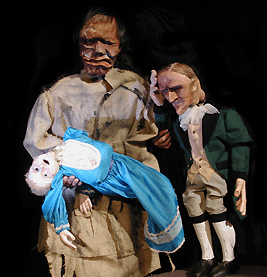
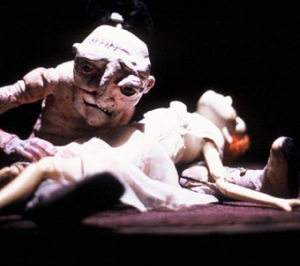
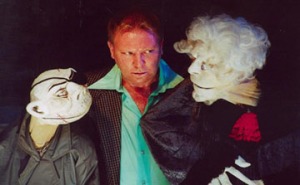
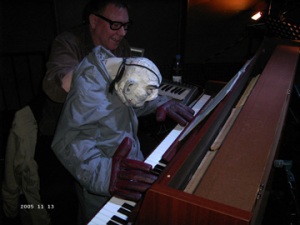

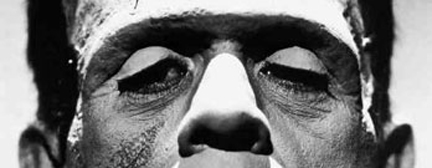

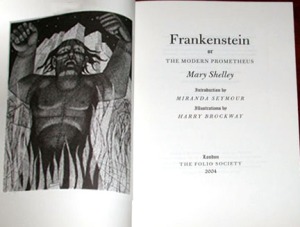
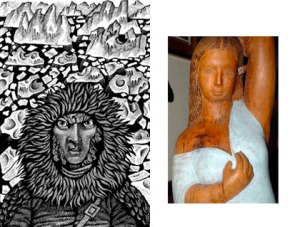
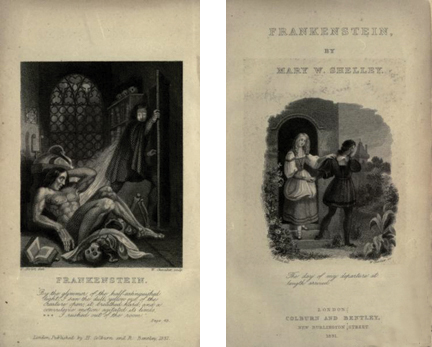
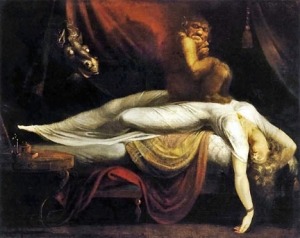
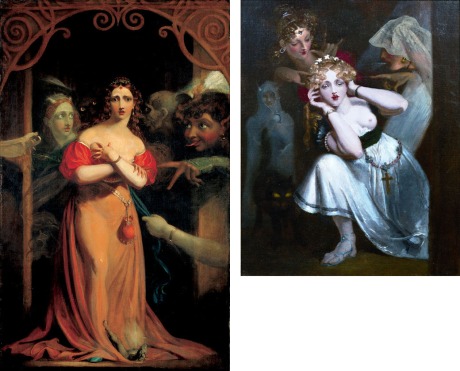
You must be logged in to post a comment.